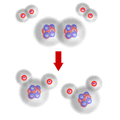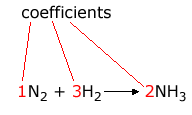|
A chemical reaction has happened when new substances are formed. All chemical compounds can be represented by a chemical formula showing the ratio of atoms or ions within the simplest formula unit. A chemical equation shows the chemical change that happens in terms of the substances reacting (the reactants) and the new substances produced (the products): Reactants |

|
Word equations
Word equations simply show the names of the reacting chemical and products. They are of limited use except for giving an overall description of the chemical reaction. They give no indication of the relative amounts of the reactants or products involved.
Sodium hydroxide + sulfuric
acid ![]() sodium sulfate
+ water
sodium sulfate
+ water
To make equations useful, they must show the individual formulae of the reactants and products and indicate the relative quantities in which they react. These 'formula equations' are dealt with below.
Formula equations and coefficients
Formula equations show the formulae of the reactants and the products on either side. Balancing numbers are used - called the coefficients of the reaction - to ensure that the numbers of particles on both sides of the equation are equal.

In this equation one nitrogen molecule is needed to react with every three hydrogen molecules to produce 2 molecules of ammonia. The coefficient of nitrogen is 1, that of hydrogen is 3, and that of ammonia is 2.
To balance a chemical equation it is important to remember that the formula of the reactants and products cannot be changed and that coefficients may only be placed before the formulae, multiplying them by whole numbers.
|
Example: One stage in the manufacture of nitric acid is the oxidation of ammonia, as shown below:
4NH3 + _O2
What is the coefficient for O2 when the equation is balanced? Solution: Balance the nitrogen by counting up the nitrogen atoms on both sides:
4NH3 + _O2 Balance the hydrogen atoms: 4NH3 + _O2 Now balance the oxygen atoms: 4NH3 + 5O2
Correct response : Coefficient = 5 |
These show the actual numbers of reacting particles in a chemical reaction. The reaction must be BALANCED to give the correct number of particles on each side of the reaction arrow.
2NaOH + H2SO4 ![]() Na2SO4 + 2H2O
Na2SO4 + 2H2O
These equations are constructed by writing the formula of each of the compounds in the reaction, and then by counting up the number of atoms on each side to make sure they are equal. If they are not equal, balancing numbers (coefficients) are added in front of each chemical formula (where needed), so that the numbers of each type of particle on each side of the equation are the same
Step 1 - write the chemical equation
| ammonia + oxygen |
Step 2 - write the formula of each of the reaction components
|
ammonia + oxygen NH3 + O2 |
Step 3 - add coefficients IN FRONT OF the formulae to balance the equation
| 4NH3 + 5O2
|
Note Whenever an exam question asks for an equation, it is the balanced formula equation that is required, unless specified otherwise.
Ionic equations
When ionic solutions react, the reaction only usually involves some of the ions and not others. An ionic equation shows just the ions implicated in the reaction. The other ions are often called "spectator ions".
2NaOH + H2SO4 ![]() Na2SO4 + 2H2O
Na2SO4 + 2H2O
The ionic equation is written as:
H+ + OH- ![]() H2O
H2O
Although the formula equation represents the overall process, the sodium ions start off in solution as Na+(aq) and at the end of the reaction they are still Na+(aq), nothing has changed, they are merely spectator ions.
The same applies to the sulfate ions, SO42-. The only particles that actually react are the OH- ions from the sodium hydroxide and the H+ ions from the sulfuric acid.
State symbols
These are used to show the states of the various compounds that constitute the equation for the reaction.
(s) means that the compound is in the solid state.
(l) means that the compound is in the liquid state.
(g) means that the compound is in the gaseous state.
(aq) means that the compound is dissolved in water, i.e. it is in solution.
2NaOH(aq) + H2SO4(aq)
![]() Na2SO4(aq)
+ 2H2O(l)
Na2SO4(aq)
+ 2H2O(l)
The sodium hydroxide and the sulfuric acid are in solution. These make sodium sulfate in solution and water liquid.
 Products
Products
